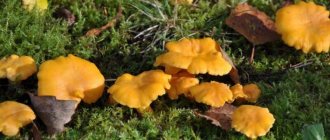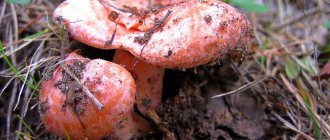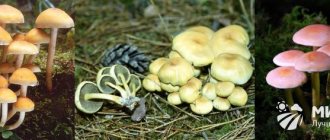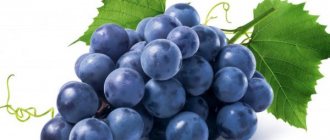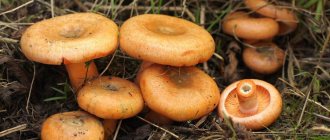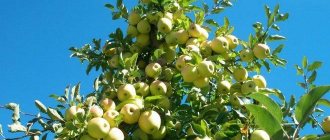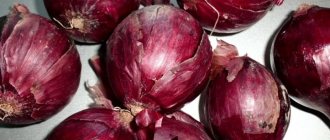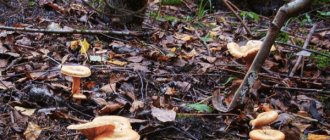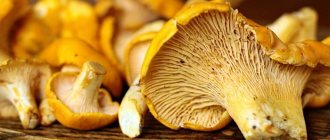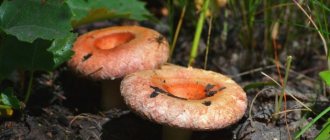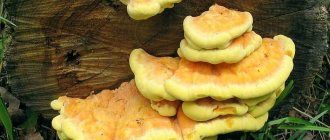Saffron milk caps
Rizhik, thanks to its taste and appetizing appearance, is deservedly considered one of the best mushrooms of the Russula family. You can find several species in the forests and, having spotted any of them, you need to hurry up and collect delicious orange mushrooms, since they quickly become worm-like and age, crumbling into dust.
These mushrooms got their sonorous name not only for the bright color of their skin, but also for their inherent carrot-orange color of milky juice.
Main types of saffron milk caps
Pine mushroom (Lactarius deliciosus)
Pine mushroom (Lactarius deliciosus)
It grows in pine forests and mixed forests, is found more often than others, and is distinguished by the reddish-red color of the fruiting bodies and the strong, stocky appearance of the mushrooms. The orange-yellow cap is round, 5–18 cm in diameter, with dark concentric zones, initially convex, over time the edges rise, forming a wide funnel. The hat is slippery to the touch and sticky in rainy weather. The plates are frequent, narrow, yellowish. The height of the hollow leg is up to 9 cm.
At the break of the pulp, an orange, milky, sweetish juice emerges with a pungent taste and smell of resin, which quickly turns green in the air. When removed, the mushroom acquires a slightly greenish tint, especially in places where it is touched.
The pulp is dense and when pickled, these mushrooms look very attractive.
Spruce mushroom (Lactarius deterrimus)
Spruce mushroom (Lactarius deterrimus)
Spruce mushrooms form mycorrhiza with the roots of spruce trees and grow only near these trees. The color of the cap is light orange, with darker rings and spots, and over time it acquires a dark green, coniferous hue. Under the sun, the skin tends to fade and become whitish. The stem is thin, 3–7 cm high, brittle, the cap is fragile, especially at the edges, which is why spruce trees often wrinkle and break in baskets.
Milky reddish juice is released in large quantities, it tastes good, and turns green in the air. When salted, spruce trees are very tasty and fragrant, but acquire a dark, greenish-brown hue.
Red camel (Lactarius sanguifluus)
Red camel (Lactarius sanguifluus)
The species is widespread in pine and spruce forests, characterized by a dense cap of reddish-pink or orange color, up to 10 cm in diameter with folded edges and a depression in the center, without an adhesive coating. The flesh is light, with a pinkish tint and burgundy spots. The milky juice is rich red in color, darkens over time, acquiring a red-brown color.
The leg is strong, up to 6 cm high, narrows at the base, covered with a characteristic powdery coating and small crimson pits over the entire surface. The color of the leg varies - from yellow-orange to purple. The species is edible, suitable for pickling and preparing a variety of mushroom dishes.
Milky red camel (Lactarius semisanguifluus)
Milky red camel (Lactarius semisanguifluus)
This beautiful bright mushroom is found near pine trees. The cap is fleshy, up to 9 cm in diameter, flat, with a slightly depressed center and folded edges. The skin is light orange, pink at the edges, and over time a greenish tone appears at the center. The plates are frequent, narrow, orange in color with a characteristic pink tint; in an aging mushroom they become reddish.
The milky juice is orange at first, then turns red and green. The taste is pleasant and soft. Hollow leg up to 7 cm high, narrow, fragile. The pulp is brittle, orange, and turns greenish when broken.
First aid
In case of mushroom poisoning, the time factor plays an important role. At the first signs of illness, you should immediately call an ambulance.
Before the doctors arrive:
- Clear the stomach of mycotoxins: drink at least 1.5 - 2 liters of salted water and induce vomiting.
- Bind toxins in the intestines by taking up to 10 tablets of activated carbon (usually take 1 tablet of this sorbent per 10 kg of the victim’s weight).
- Take a laxative.
If possible, find out what mushrooms the poisoning occurred and then report this information to doctors.
saffron milk mushrooms beneficial properties, how to cook saffron milk caps, false saffron milk caps, salted saffron milk caps,
Mushrooms Rizhiki. For a beginner mushroom picker
One of the best. Spruce mushroom - Lactarius deterrimus
Where and when do saffron milk caps grow?
Saffron milk caps of all types prefer coniferous forests, but can also grow in mixed plantings under pine or spruce trees. Favorite places are forest edges, forest clearings, clearing areas, young spruce and pine forests. These mushrooms are most often found in the northern regions, forests of the Urals and Siberia.
Finding saffron milk caps can be difficult - they hide in groups under fallen soft pine needles, in dry weather there are almost no of them, and after drizzling summer and autumn rains they suddenly appear en masse, raising their shelters of pine needles and grass, highlighting a warm orange color to match the color of pine bark.
Harvesting begins in July, the main harvest falls in August and lasts until September. Experienced mushroom pickers notice where orange mushrooms grow and after each rain they collect fragrant forest harvests again and again.
False saffron milk caps (doubles)
Saffron milk caps are valuable edible mushrooms of the Milky genus, which, when broken, secrete abundant orange-red milky juice. The advantage of this characteristic is that they cannot be confused with inedible and dangerous species.
However, due to inexperience, other, not so tasty and aromatic mushrooms of this genus, classified as conditionally edible, can be mistaken for the noble saffron milk cap.
Pink trumpet (Lactarius torminosus)
Pink trumpet (Lactarius torminosus)
It is characterized by white milky juice that does not darken in air. This mushroom grows in deciduous forests at the roots of birch trees and is more common in northern regions. In addition to the white color of the milky juice, the pink wave is distinguished by a soft pink cap with fringed edges turned down and whitish flesh at the break.
Eating pink salmon if it is not properly boiled or salted for less than 45 days can cause problems with the functioning of the stomach and intestines.
Large milkweed or papillary breast (Lactarius mammosus)
Large milkweed or papillary breast (Lactarius mammosus)
Another conditionally edible mushroom of the same genus, growing in coniferous forests, often on light sandy loam. It is distinguished by a grayish-brown dry cap and white milky juice that does not darken in air. The pulp is white, brittle; if you rub it between your fingers, you can smell a faint coconut smell.
This species is used for food after soaking and prolonged salting.
Fragrant milkweed (Lactarius glyciosmus)
Fragrant milkweed (Lactarius glyciosmus)
A small mushroom with a cap diameter of up to 6 cm, which is characterized by a beige or ocher color and rolled up edges. The pulp is light, the milky juice is white, does not change color, the smell is strong, coconut.
It is used as a spicy additive to other dishes and in pickled form.
Chemical composition
The orange color of camelina confirms that it contains beta-carotene. It is an antioxidant that prevents the occurrence of eye diseases and improves visual acuity.
In order for the body to better absorb this component, it is recommended to consume the product together with vegetable oil or sour cream. This improves the functioning of the gastrointestinal tract.
The chemical composition of saffron milk caps contains:
- microelements - they improve metabolic processes and prevent stagnation;
- vitamins B and C – increase immune abilities, relieve vitamin deficiency;
- Lactarioviolin is a natural antibiotic. It prevents the spread of pathogenic microorganisms. Relieves the inflammatory process. Excellent effect on the functioning of the respiratory system;
- amino acids – improve skin condition, have a positive effect on the functioning of the gastrointestinal tract.
It is known that camelina has powerful tonic properties. You will only be able to get a positive effect from them if you prepare the product well. It’s easy to check: cut off a small part and see if milky juice appears.
Beneficial features
The orange flesh of saffron milk caps is so brightly colored due to the presence of carotene or provitamin A, which acts as a powerful antioxidant, strengthens the immune system, reduces the risk of cholesterol plaques, and supports the barrier function of mucous membranes.
In addition, mushroom tissues contain B vitamins (thiamine and riboflavin), ascorbic acid and a whole group of minerals necessary for the body - iron, potassium, phosphorus and calcium .
In saffron milk caps, this natural treasure trove of useful substances, a natural, potent antibiotic, lactrioviolin , was found, which inhibits many harmful bacteria, including the tuberculosis bacillus. It is the presence of this antibacterial compound that determines the harmlessness of the mushroom, which can be eaten during mushroom hunting directly in its raw form, adding a little salt or lightly frying over a fire.
In the old days, red mushrooms were prepared very simply - wiped with a canvas cloth, they were loaded into cedar barrels, fumigated with juniper branches, and pickled directly in the forest, immediately after collection.
The satiety and nutritional value is due to the presence of easily digestible amino acids and as a source of protein, these mushrooms are comparable to the best varieties of meat. In terms of calories and energy content, they are superior to beef, poultry and even chicken eggs. Therefore, orange mushrooms are a desirable product on the table of vegetarians or during fasting.
Recipes for cooking dishes from saffron milk caps
Knowledgeable mushroom pickers believe that real saffron milk caps should be eaten salted without spices , then they acquire an incomparable forest taste, taste of pine needles, and a slight bitterness of pine resin. Therefore, mushrooms are pickled immediately after collection, wiped with a clean cloth, placed tightly in a container and generously sprinkled with salt. These pickles are eaten after 10–14 days.
The need for rapid harvesting of saffron milk caps is justified not only by their excellent taste, like other mushrooms, it is a perishable product that should be processed as soon as possible.
Salted saffron milk caps with spices
At home you can prepare delicious savory mushrooms, which are obtained by cold pickling. To do this, for 1 kg of saffron milk caps, take 40 g of salt, a little bay leaf and black currant leaves, allspice and ground black pepper to taste.
The mushrooms are doused with boiling water twice, first poured onto a sieve, then doused with cold water and left to dry a little.
Place salt and spices at the bottom of the container, mixing them and spreading them in a thin layer. Then lay out the saffron milk caps, caps on top, in rows up to 7 cm thick, each layer is salted and peppered. Place all the remaining spices on top. The workpiece is covered with a piece of cotton fabric, a wooden circle, pressed down with pressure and taken to the basement. It is convenient to use a glass bottle of water as a pressure.
After a few days, brine appears and, if it is not there, the severity of the oppression is increased. Excess brine is drained if necessary. These spicy mushrooms can be eaten after a month, and the snack is stored in the refrigerator.
Baked marinated saffron milk caps
This delicious original appetizer will serve as an excellent decoration for the holiday table. And in terms of juiciness and forest aroma, it cannot be compared with any store-bought delicacies.
To prepare the marinade take:
- 1 liter of vinegar 3.5% strength;
- 20 g sugar;
- 20 g salt;
- 5–7 bay leaves;
- a little clove.
All components are mixed and brought to a boil.
Place the peeled saffron milk caps, washed under running water, on a baking sheet and place in a hot oven for 10–12 minutes. Then they take it out of the oven, cool it a little, put it in jars while still warm and pour it with hot marinade.
After this, the jars are sealed with plastic lids and, as soon as they have cooled, they are placed in the refrigerator. For long-term storage, canned food is covered with metal lids, sterilized for 30–40 minutes, and then sealed.
Saffron milk caps in sour cream
The classic mushroom dish turns out especially tasty when using saffron milk caps. To prepare, follow these steps:
- Finely chop the onion and fry until golden brown.
- Mushrooms are cleaned, washed, large ones are cut into halves, lightly sprinkled with flour and fried.
- Combine mushrooms and onions, add sour cream and heat until boiling.
The dish is salted, ground pepper, finely chopped dill and other spices are added to taste.
Death cap
Confusing saffron milk caps with toadstools is difficult and very dangerous to health. Pale toadstool belongs to the genus Amanita and is considered a very poisonous mushroom, poisoning from which can be fatal.
The toadstool has a funnel-shaped cap with smooth edges. The color of the cap is variable: from yellowish to olive. In the central part it is a tone darker, and at the edges it is a tone lighter. The hat is attached to a thin elongated stem. Between them is a white skirt.
The only common feature between the mushrooms is the funnel-shaped cap. But in saffron milk caps it has a curled edge, while in the toadstool it has a smooth edge. To dispel all doubts, you need to cut the mushroom: the edible one will give white juice, which will soon turn green, and the toadstool will remain dry. It should also be noted that adult grebe emits an unpleasant, sickly-sweet odor.
We invite you to familiarize yourself with Juniper: medicinal properties and contraindications
